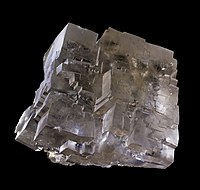
Photo from wikipedia
Abstract The inhibition effect of one of the pyridine derivative (2,6-dimethylpyridine) on aluminum corrosion in 1.0 M NaCl, HCl and NaOH solutions was investigated using electrochemical impedance spectroscopy (EIS), Tafel polarization,… Click to show full abstract
Abstract The inhibition effect of one of the pyridine derivative (2,6-dimethylpyridine) on aluminum corrosion in 1.0 M NaCl, HCl and NaOH solutions was investigated using electrochemical impedance spectroscopy (EIS), Tafel polarization, open circuit potential (OCP), Fourier transform infrared spectroscopy (FT-IR) and quantum chemical modeling. FT-IR spectrums indicate the adsorption of inhibitor molecules on aluminum surface. EIS and polarization experiments confirm 2,6-dimethylpyridine retards aluminium corrosion through adsorption on the surface sites obeying the Langmuir isotherm in NaCl and NaOH solutions and Freundlich in HCl. Distinctive molecular parameters relevant to 2,6-dimethylpyridine inhibition quality are explored using the density functional theory (DFT); a known quantum chemical method, confirming nitrogen with its pair electrons adsorbing on the aluminum surface. Overall, 2,6-dimethylpyridine controls corrosion of aluminum in NaOH, NaCl and HCl environments.
Journal Title: Materials Chemistry and Physics
Year Published: 2020
Link to full text (if available)
Share on Social Media: Sign Up to like & get
recommendations!